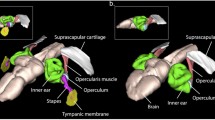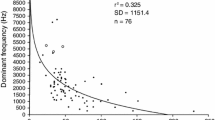Abstract
Social communication in anuran amphibians (frogs and toads) is mediated predominantly by acoustic signals. Unlike most anurans, the Panamanian golden frog, Atelopus zeteki, lacks a standard tympanic middle ear and appears to have augmented its communicatory repertoire to include rotational limb motions as visual signals, referred to here as semaphores. The communicatory nature of semaphoring was inferred from experimental manipulations using mirrored self-image presentations and nonresident introductions. Male frogs semaphored significantly more when presented with a mirrored self-image than with a nonreflective control. Novel encounters between resident males and nonresident frogs demonstrated that semaphores were used directionally and were displayed toward target individuals. Females semaphored frequently and this observation represents a rare case of signaling by females in a typically male-biased communicatory regime. Semaphore actions were clearly linked to a locomotory gait pattern and appear to have originated as an elaboration of a standard stepping motion.
Similar content being viewed by others
References
Clemmons JR, Lambrechts MM (1992) The waving display and other nest site anti-predator behavior of the black-capped chickadee. Wilson Bull 104:749–756
Crump ML (1988) Aggression in harlequin frogs: male-male competition and a possible conflict of interest between the sexes. Anim Behav 36:1064–1077
Davison G (1984) Foot-flagging displays in Bornean frogs. Sarawak Mus J 33:177–178
Ehret G, Tautz J, Schmitz B (1990) Hearing through the lungs: lungeardrum transmission of sound in the frog Eleutherodactylus coqui. Naturwissenschaften 77:192–194
Harding KA (1982) Courtship display in a Bornean frog. Proc Biol Soc Wash 95:621–624
Hetherington TE (1992) The effects of body size on functional properties of middle ear systems in anuran amphibians. Brain Behav Evol 39:133–142
Heyer WR, Rand AS, Da Cruz CAG, Peixoto OL, Nelson CE (1990) Frogs of Boracea. Arq Zool 31:231–410
Hyatt GW (1977) Field studies of size-dependent changes in waving display and other behavior in the fiddler crab, Uca pugilator (Brachyura, Ocypodidae) Mar Behav Physiol 4:283–292
Ibáñez RD, Jamarillo CA, Solís FA (1995) Una especie nueva de Atelopus (Amphibia: Bufonidae) de Panamá. Carib J Sci 31: 57–64
Jaslow AP, Lombard RE (1996) Hearing in the Neotropical frog. Atelopus chiriquiensis. Copeia 1996:428–432
Jaslow AP, Hetherington TE, Lombard RE (1988) Structure and function of the amphibian middle ear. In: Fritzsch B, Ryan MJ, Wilczynski W, Hetherington TE, Walkowiak W (eds) The evolution of the amphibian auditory system. Wiley, New York, pp 69–92
Lindquist ED, Hetherington TE (1996) Field studies on visual and acoustic signaling in the “earless” Panamanian golden frog, Atelopus zeteki. J Herpetol 30:347–354
Lindquist ED, Hetherington TE, Volman SF (1998) Biomechanical and neurophysiological studies on audition in eared and earless harlequin frogs (Atelopus). J Comp Phys A 183:265–271
Norušis MJ (1993) SPSS for Windows, release 6.0. SPSS, Chicago
Pombal JP Jr, Sazima I, Haddad CFB (1994) Breeding behavior of the pumpkin toadlet, Brachycephalus ephippium (Brachycephalidae). J Herpetol 28:516–519
Richards SJ, James C (1992) Foot-flagging displays of some Australian frogs. Mem Qd Mus 32:302
Roy D, Bijoylakshmi B, Sarma A (1995) Analysis and significance of female reciprocal call in frogs. Curr Sci 69:265–270
Smith, S. M. (1996) The single wing-flick display of the blackcapped chickadee. Condor 98:885–887
Smith WJ (1977) The behavior of communicating: an ethological approach. Harvard University Press, Cambridge
Wells KD (1977) The courtship of frogs. In: Taylor DH, Guttman SI (eds) The reproductive biology of amphibians. Plenum, New York, pp 233–262
Wells KD (1988) The effect of social interactions on anuran vocal behavior. In: Fritzsch B, Ryan MJ, Wilczynski W, Hetherington TE, Walkowiak W (eds) The evolution of the amphibian auditory system. Wiley, New York, pp 433–454
Wever EG (1985) The amphibian ear. Princeton University Press, Princeton
Wevers E (1988) Some observations on the “pijlgifkikker” Dendrobates parvulus (in Dutch). Lacerta 46:51–53
Winter J, McDonald KR (1986) Eungella: the land of the cloud. Aust Nat Hist 22:39–43
Zucker N (1983) Courtship variation in the neo-tropical fiddler crab, Uca deichmanni: another example of female incitation to male competition? Mar Behav Physiol 10:57–79
Author information
Authors and Affiliations
Rights and permissions
About this article
Cite this article
Lindquist, E., Hetherington, T. Semaphoring in an earless frog: the origin of a novel visual signal. Anim Cogn 1, 83–87 (1998). https://doi.org/10.1007/s100710050012
Received:
Revised:
Published:
Issue Date:
DOI: https://doi.org/10.1007/s100710050012




